When Will Rossi Guns Hit the Market Again?


A revolver (besides called a vi shooter or a wheel gun [1] [2]) is a repeating handgun that has at least one barrel and uses a revolving cylinder containing multiple chambers (each holding a unmarried cartridge) for firing. Before firing a round, cocking the hammer partially rotates the cylinder, indexing one of the cylinder chambers into alignment with the barrel, allowing the bullet to be fired through the diameter. The hammer cocking tin be achieved by either the user manually pulling the hammer dorsum (as in single-action), via internal linkage relaying a rearward movement of the trigger (as in double-action), or both (as in double/single-activeness). By sequentially rotating through each sleeping accommodation, the revolver allows the user to fire multiple times until having to reload the gun, dissimilar older single-shot firearms that had to be reloaded afterward each shot.
Although largely surpassed in convenience and ammunition chapters by semi-automatic pistols, revolvers still remain popular as back-up and off-duty handguns among American police enforcement officers and security guards and are even so common in the American private sector every bit defensive, sporting, and hunting firearms. Famous revolvers models include the Colt 1851 Navy Revolver, the Webley, the Colt Single Action Ground forces, the Colt Official Police, Smith & Wesson Model 10, the Smith & Wesson Model 29 of Dirty Harry fame, the Nagant M1895, and the Filly Python.
Though the majority of weapons using a revolver mechanism are handguns, other firearms may also have a revolver action. These include some models of rifles, shotguns, grenade launchers, and cannons. Revolver weapons differ from Gatling-style rotary weapons in that in a revolver just the chambers rotate, while in a rotary weapon there are multiple total firearm actions with their own barrels which rotate effectually a mutual armament feed.
History [edit]
In the development of firearms, an important limiting factor was the time required to reload the weapon afterward it was fired. While the user was reloading, the weapon was useless, allowing an adversary to attack the user. Several approaches to the problem of increasing the charge per unit of fire were developed, the primeval involving multi-barrelled weapons which allowed two or more shots without reloading.[three] Later weapons featured multiple barrels revolving along a single axis.
A revolving iii-barrelled matchlock pistol in Venice is dated from at least 1548.[4] During the late 16th century in Mainland china, Zhao Shi-zhen invented the Xun Lei Chong, a five-barreled musket revolver spear. Around the same time, the earliest examples of what today is chosen a revolver were made in Germany. These weapons featured a single butt with a revolving cylinder holding the powder and ball. They would soon be made by many European gun-makers, in numerous designs and configurations.[5] However, these weapons were complicated, hard to employ and prohibitively expensive to brand, and every bit such they were not widely distributed.
In the early 19th century, multiple-barrel handguns called "pepper-boxes" were popular. Originally they were muzzleloaders, simply in 1837, the Belgian gunsmith Mariette invented a hammerless pepperbox with a ring trigger and turn-off barrels that could be unscrewed.[6]
In 1836, American Samuel Colt patented a popular revolver which led to the widespread utilize of the revolver.[seven] According to Colt, he came up with the idea for the revolver while at sea, inspired by the capstan, which had a ratchet and pawl mechanism on it, a version of which was used in his guns to rotate the cylinder by cocking the hammer. This provided a reliable and repeatable way to index each round and did away with the need to manually rotate the cylinder. Revolvers proliferated largely due to Colt'south ability as a salesman,[ citation needed ] but his influence spread in other means likewise. The build quality of his company'southward guns became famous, and its armories in America and England trained several seminal generations of toolmakers and other machinists, who had great influence in other manufacturing efforts of the next half century.[viii]
-
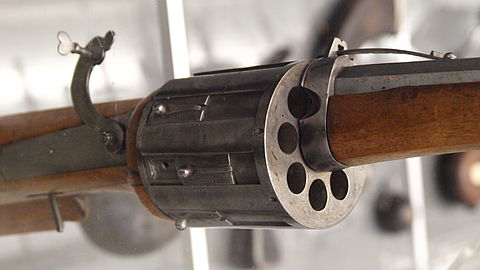
Detail of an 8-chambered matchlock revolver (Germany c. 1580)
-

Colt Paterson 2nd chugalug model
Early revolvers were caplocks and muzzleloaders: the user poured blackness powder into each chamber, rammed downwards a bullet on top of it, so placed a percussion cap on the nipple at the rear of each chamber, where the hammer would fall on information technology. This was like to loading a traditional single-shot cage-loading pistol, except that the powder and shot could exist loaded directly into the front of the cylinder rather than having to be loaded downwardly the whole length of the barrel. Importantly, this allowed the barrel itself to be rifled, since the user was non required to force the tight-plumbing fixtures bullet down the barrel in society to load it (a traditional muzzle-loading pistol had a smoothbore and relatively loose-plumbing equipment shot, which allowed easy loading, but gave much less accuracy). When firing the next shot, the user would raise his pistol vertically as he cocked the hammer back so as to let the fragments of the burst percussion cap autumn out so as to non jam the machinery. Some of the most pop cap-and-brawl revolvers were the Colt Model 1851 "Navy" model, 1860 "Ground forces" model, and Colt Pocket Percussion Revolvers, all of which saw extensive use in the American Civil War. Although American revolvers were the most common, European arms makers were making numerous revolvers by that time equally well, many of which establish their style into the hands of the American forces. These included the unmarried-activity Lefaucheux and LeMat revolvers and the Beaumont–Adams and Tranter revolvers—early double-activity weapons in spite of being muzzle-loaders.[9]
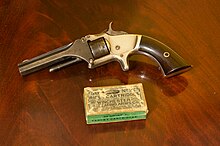
A Smith & Wesson Model ane, second outcome; a two patent date diversity shown adjacent to a period box of .22 Short black powder cartridges
In 1854, Eugene Lefaucheux introduced the Lefaucheux Model 1854, the get-go revolver to use self-contained metal cartridges rather than loose powder, pistol brawl, and percussion caps. It is a single-action, pinfire revolver property six rounds.[ten]
On November 17, 1856, Daniel B. Wesson and Horace Smith signed an understanding for the exclusive use of the Rollin White Patent at a rate of 25 cents for every revolver. Smith & Wesson began production late in 1857, and enjoyed years of sectional production of rear-loading cartridge revolvers in America due to their clan with Rollin White, who held the patent[11] and vigorously defended information technology against any perceived infringement past other manufacturers (much as Colt had done with his original patent on the revolver). Although White held the patent, other manufacturers were able to sell firearms using the design, provided they were willing to pay royalties.[12] [13]
Afterward White's patent expired in Apr 1869, a tertiary extension was refused. Other gun-makers were then allowed to produce their own weapons using the rear-loading method, without having to pay a royalty on each gun sold. Early on guns were often conversions of earlier cap-and-ball revolvers, modified to accept metallic cartridges loaded from the rear, merely afterward models, such every bit the Colt Model 1872 "open meridian" and the Smith & Wesson Model 3, were designed from the beginning as cartridge revolvers.[12]

In 1873, Colt introduced the famous Model 1873, also known as the Single Action Army, the "Colt .45" (not to be dislocated with Filly-made models of the M1911 semi-automatic) or simply, "the Peacemaker", one of the nigh famous handguns ever made.[14] This popular design, which was a culmination of many of the advances introduced in earlier weapons, fired 6 metallic cartridges and was offered in over 30 different calibers and diverse butt lengths. It is still in product, forth with numerous clones and lookalikes, and its overall advent has remained the same since 1873. Although originally made for the United States Army, the Model 1873 was widely distributed and popular with civilians, ranchers, lawmen, and outlaws alike.[ commendation needed ] Its design has influenced endless other revolvers. Filly has discontinued its production twice, but brought information technology dorsum due to popular demand and continues to go far to this day.
In the U.S., the traditional single-action revolver still reigned supreme until the late 19th century. In Europe, nevertheless, artillery makers were quick to prefer the double-action trigger. While the U.Due south. was producing weapons like the Model 1873, the Europeans were edifice double-action models similar the French MAS Modèle 1873 and the somewhat later British Enfield Mk I and II revolvers (Britain relied on cartridge conversions of the earlier Beaumont–Adams double-action prior to this). Colt's showtime try at a double action revolver to compete with the European manufacturers was the Colt Model 1877, which earned lasting notoriety for its overly complex, expensive and delicate trigger mechanism, which in add-on to failing frequently, as well had a terrible trigger pull unless given the attentions of a competent gunsmith.

Smith & Wesson Thousand&P revolver
In 1889, Filly introduced the Model 1889, the first truly mod double action revolver, which differed from earlier double action revolvers by having a "swing-out" cylinder, equally opposed to a "top-break" or "side-loading" cylinder. Swing out cylinders apace caught on, because they combined the best features of earlier designs. Top-interruption deportment gave the ability to eject all empty shells simultaneously, and exposed all chambers for easy reloading, but having the frame hinged into two halves weakened the gun and negatively affected accuracy, due to lack of rigidity. "Side-loaders", similar the before Colt Model 1871 and 1873, gave a rigid frame, but required the user to squirt and load one chamber at a time as they rotated the cylinder to line each chamber upward with the side-mounted loading gate.[15] Smith & Wesson followed seven years later on with the Paw Ejector, Model 1896 in .32 S&W Long caliber, followed by the very similar, yet improved, Model 1899 (later known as the Model x), which introduced the new .38 Special cartridge. The Model x went on to become the best selling handgun of the 20th century, at 6,000,000 units, and the .38 Special is however the nigh popular chambering for revolvers in the world. These new guns were an improvement over the Colt 1889 design since they incorporated a combined center-pin and ejector rod to lock the cylinder in position. The 1889 did non use a center pivot and the cylinder was prone to motion out of alignment.[15]
Revolvers have remained pop to the nowadays day in many areas, although in the military and law enforcement, they have largely been supplanted by magazine-fed semi-automated pistols such every bit the Beretta M9 and the SIG Sauer M17, especially in circumstances where reload fourth dimension and college cartridge capacity are accounted important.[sixteen]
Patents [edit]
Elisha Collier of Boston, Massachusetts, patented a flintlock revolver in Uk in 1818, and significant numbers were being produced in London by 1822.[17] The origination of this invention is in doubt, as similar designs were patented in the same year by Artemus Wheeler in the United states, and by Cornelius Coolidge in France.[18] Samuel Colt submitted a British patent for his revolver in 1835 and an American patent (number 138) on February 25, 1836, for a Revolving gun, and made the showtime product model on March 5 of that twelvemonth.[19]
Another revolver patent was issued to Samuel Colt on Baronial 29, 1839. The Feb 25, 1836, patent was then reissued every bit U.S. Patent RE00124 entitled Revolving gun on October 24, 1848. This was followed by U.Due south. Patent 0,007,613 on September 3, 1850, for a Revolver, and by U.S. Patent 0,007,629 on September 10, 1850, for a Revolver. U.S. Patent 5,333,531 was issued to Roger C. Field for an economic device for minimizing the wink gap of a revolver betwixt the barrel and the cylinder. In 1855, Rollin White patented the bored-through cylinder entitled Comeback in revolving fire-arms U.Due south. Patent 00,093,653. In 1856, Horace Smith & Daniel Wesson formed a partnership (S&W), adult and manufactured a revolver chambered for a self-contained metallic cartridge.[twenty]
Blueprint [edit]
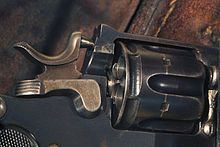
Details of a Schmidt M1882, showing the hammer, chambers for the armament in the cylinder, and the machinery to rotate the cylinder. Revolver of the Gendarmerie of Vaud, on brandish at Morges castle museum
A revolver works by having several firing chambers bundled in a circumvolve in a cylindrical block that are brought into alignment with the firing mechanism and barrel one at a time. In dissimilarity, other repeating firearms, such as commodities-activity, lever-activity, pump-activeness, and semi-automatic, have a single firing bedchamber and a mechanism to load and extract cartridges into information technology.[21]
A unmarried-action revolver requires the hammer to be pulled back by hand before each shot, which also revolves the cylinder. This leaves the trigger with merely one "unmarried activity" left to perform - releasing the hammer to burn the shot - so the force and distance required to pull the trigger can be minimal. In dissimilarity, with a self-cocking revolver, i long clasp of the trigger pulls back the hammer and revolves the cylinder, then finally fires the shot. They can generally be fired faster than a single-action, just with reduced accurateness in the easily of most shooters.[21]
Most modern revolvers are "traditional double-action", which means they may operate either in single-activeness or self-cocking way. The accustomed meaning of "double-action" has, confusingly, come up to be the same as "self-cocking", so modern revolvers that cannot be pre-artsy are called "double-action-only".[21] These are intended for concealed carry, because the hammer of a traditional blueprint is decumbent to snagging on clothes when fatigued. Nigh revolvers do not come up with accompaniment track, which are used for mounting lights and lasers, except for the Smith & Wesson Thousand&P R8 (.357 Magnum),[22] Smith & Wesson Model 325 Thunder Ranch (.45 ACP),[23] and all versions of the Chiappa Rhinoceros (.357 Magnum, ix×19mm, .xl South&Westward, or nine×21mm) except for the 2" and 3" models, respectively.[24] All the same, certain revolvers, such as the Taurus Judge and Charter Arms revolvers, can be fitted with accessory rails.[25]
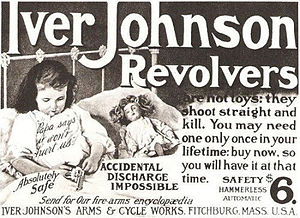
An advertisement for Iver Johnson revolvers claimed they were safe enough for children to handle.
Near commonly, such revolvers accept 5 or 6 chambers, hence the mutual names of "six-gun" or "six-shooter".[26] Even so, some revolvers have 7, 8, 9, or ten chambers,[26] often depending on the caliber, and at least one revolver has 12 chambers (the U.s. Fire Arms Model 12/22).[27] Each chamber has to exist reloaded manually, which makes reloading a revolver a much slower process than reloading a semi-automatic pistol.[26]
Compared to autoloading handguns, a revolver is oft much simpler to operate and may take greater reliability.[26] For case, should a semiautomatic pistol fail to fire, immigration the bedroom requires manually cycling the action to remove the errant circular, as cycling the action usually depends on the free energy of a cartridge firing.[26] With a revolver, this is non necessary as none of the energy for cycling the revolver comes from the firing of the cartridge, but is supplied by the user either through cocking the hammer or, in a double-activeness design, by just squeezing the trigger.[26] Another significant reward of revolvers is superior ergonomics, particularly for users with small hands.[26] A revolver's grip does not hold a magazine, and it tin can be designed or customized much more than than the grip of a typical semi-automatic.[26] Partially considering of these reasons, revolvers still agree meaning market share as concealed deport and dwelling house-defence weapons.[26]
A revolver can be kept loaded and prepare to fire without fatiguing any springs and is not very dependent on lubrication for proper firing.[26] Additionally, in the case of double-action-just revolvers there is no chance of accidental discharge from dropping alone, as the hammer is artsy by the trigger pull.[26] However, the revolver's clockwork-like internal parts are relatively delicate and tin can become misaligned after a severe impact, and its revolving cylinder tin can get jammed by excessive dirt or debris.[26]
Over the long catamenia of evolution of the revolver, many calibers take been used.[28] Some of these have proved more durable during periods of standardization and some have entered general public awareness. Among these are the .22 rimfire, a quotient popular for target shooting and didactics novice shooters; .38 Special and .357 Magnum, known for law utilize; the .44 Magnum, famous from Clint Eastwood'due south Dingy Harry films; and the .45 Colt, used in the Filly revolver of the Wild West. Introduced in 2003, the Smith & Wesson Model 500 is 1 of the most powerful revolvers, utilizing the .500 Southward&W Magnum cartridge.[29]
Because the rounds in a revolver are headspaced on the rim, some revolvers are capable of chambering more than one type of ammunition. The .44 Magnum circular will likewise bedroom the .44 Special and .44 Russian, as well the .357 Magnum will safely chamber .38 Special, .38 Long Filly, and .38 Brusque Filly. In 1996, a revolver known equally the Medusa M47 was made that could chamber 25 different cartridges with bullet diameters between .355" and .357".[xxx]
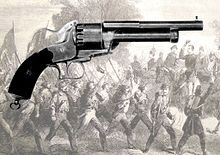
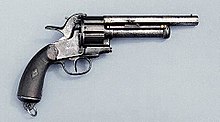
LeMat Revolver, an unusual pinfire cartridge model
Revolver applied science lives on in other weapons used by the military machine. Some autocannons and grenade launchers use mechanisms similar to revolvers, and some riot shotguns use leap-loaded cylinders belongings upwards to 12 rounds.[31] In addition to serving every bit backup guns, revolvers notwithstanding fill up the specialized niche office as a shield gun; constabulary enforcement personnel using a "impenetrable" gun shield sometimes opt for a revolver instead of a cocky-loading pistol, because the slide of a pistol may strike the front of the shield when fired. Revolvers do not suffer from this disadvantage. A 2nd revolver may be secured behind the shield to provide a quick means of continuity of fire. Many police force also still use revolvers as their duty weapon due to their relative mechanical simplicity and user friendliness.[32]
With the advocacy of technology and design in 2010, major revolver manufacturers started producing polymer frame revolvers like the Ruger LCR, Smith & Wesson Bodyguard 38, and Taurus Protector Polymer. The new innovative design incorporates advanced polymer technology that lowers weight significantly, helps absorbs recoil, and potent enough to handle .38 Special +P and .357 Magnum loads. The polymer is but used on the lower frame and joined to a metal alloy upper frame, butt, and cylinder. Polymer technology is considered one of the major advancements in revolver history considering the frame has always been metallic blend and by and large a 1 piece frame design.[33]
Another recent development in revolver technology is the Chiappa Rhino, a revolver introduced by Italian manufacturer Chiappa in 2009, and get-go sold in the U.S. in 2010. The Rhino, built with the U.S. concealed carry marketplace in heed, is designed so the bullet fires from the bottom sleeping accommodation of the cylinder instead of the summit chamber as in standard revolvers. This is intended to reduce muzzle flip, assuasive for faster and more authentic repeat shots. In addition, the cylinder cross-section is hexagonal instead of circular, further reducing the weapon's profile.[24]
Loading and unloading [edit]
Front end-loading cylinder [edit]
The get-go revolvers were front loading (also referred to as muzzleloading), and were a bit similar muskets in that the powder and bullet were loaded separately. These were caplocks or "cap and brawl" revolvers, considering the caplock method of priming was the first to be compact enough to brand a practical revolver feasible. When loading, each chamber in the cylinder was rotated out of line with the barrel, and charged from the front with loose pulverisation and an oversized bullet. Side by side, the chamber was aligned with the ramming lever underneath the barrel. Pulling the lever would drive a rammer into the bedchamber, pushing the ball securely in place. Finally, the user would place percussion caps on the nipples on the rear face up of the cylinder.[9]
After each shot, a user was advised to raise his revolver vertically while cocking back the hammer so equally to let the fragments of the spent percussion cap to fall out safely. Otherwise, the fragments could fall into the revolver's mechanism and jam information technology. Caplock revolvers were vulnerable to "chain fires", wherein hot gas from a shot ignited the powder in the other chambers. This could be prevented by sealing the chambers with cotton wool, wax, or grease. Chain burn down led to the shots striking the shooters manus, which is one of the main reasons why revolver rifles were uncommon. By the fourth dimension metal cartridges became common, more effective mechanisms for a repeating rifle, such equally lever-activity, had been adult.[34]
Loading a cylinder in this manner was a slow and awkward process and generally could not be done in the midst of battle.[35] Some soldiers solved this by carrying multiple revolvers in the field. Another solution was to use a revolver with a detachable cylinder design. These revolvers allowed the shooter to quickly remove a cylinder and supercede it with a full 1.[21]
-

Front end reloading a cap and ball pistol
-

Stock-still cylinder designs [edit]
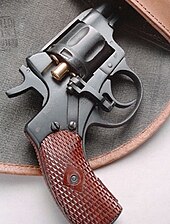
In many of the first generation of cartridge revolvers (especially those that were converted after manufacture), the base of operations pivot on which the cylinder revolved was removed, and the cylinder taken from the revolver for loading. Most revolvers using this method of loading are unmarried-action revolvers, although Iver Johnson produced double-action models with removable cylinders. The removable-cylinder design is employed in some modern "micro-revolvers" (unremarkably chambered in .22 rimfire), in order to simplify their blueprint. These weapons are minor enough to fit in the palm of the hand.[33]
Later single-activity revolver models with a fixed cylinder used a loading gate at the rear of the cylinder that allowed insertion of one cartridge at a time for loading, while a rod nether the barrel could be pressed rearward to eject the fired case.[36]
The loading gate on the original Colt designs (and on nearly all single-action revolvers since, such as the famous Colt Unmarried Action Army) is on the right side, which was washed to facilitate loading while on horseback; with the revolver held in the left manus with the reins of the horse, the cartridges can exist ejected and loaded with the correct manus.[37]
Because the cylinders in these types of revolvers are firmly attached at the front and rear of the frame, and the frame is typically full thickness all the way around, fixed cylinder revolvers are inherently strong designs. Accordingly, many mod big quotient hunting revolvers tend to be based on the fixed cylinder design. Fixed cylinder revolvers tin can burn the strongest and most powerful cartridges, but at the price of existence the slowest to load or unload, as they cannot use speedloaders or moon clips for loading, as only ane sleeping accommodation is exposed at a time to the loading gate.[38]
Top-break cylinder [edit]
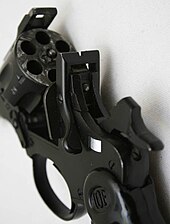
In a top-break revolver, the frame is hinged at the bottom front end of the cylinder. Releasing the lock and pushing the butt down exposes the rear face of the cylinder. In most superlative-break revolvers, this act too operates an extractor that pushes the cartridges in the chambers back far plenty that they will fall complimentary, or can be removed easily. Fresh rounds are then inserted into the cylinder. The barrel and cylinder are then rotated back and locked in identify, and the revolver is ready to fire.[21]
Tiptop-break revolvers are able to be loaded more apace than fixed frame revolvers, especially with the assistance of a speedloader or moon clip. Notwithstanding, this pattern is much weaker and cannot handle high pressure rounds. While this blueprint is mostly obsolete today, supplanted by the stronger even so equally convenient swing-out cylinder pattern, manufacturers take begun making reproductions of belatedly 19th century designs for use in cowboy action shooting.[21]
The first top-break revolver was patented in French republic and United kingdom at the terminate of December in 1858 by Devisme.[39] The most commonly found top-break revolvers were manufactured past Smith & Wesson, Webley & Scott, Iver Johnson, Harrington & Richardson, Manhattan Fire Arms, Meriden Arms and Forehand & Wadsworth.[40]
Tip-up cylinder [edit]
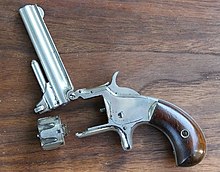
Smith & Wesson Model 1 Third Consequence open
The tip-up revolver was the kickoff design to exist used with metal cartridges in the Smith & Wesson Model i, on which the butt pivoted upwardly, hinged on the forward end of the topstrap. On the S&W tip-up revolvers, the barrel release catch is located on both sides of the frame in front of the trigger. Smith & Wesson discontinued information technology in the third series of the Smith & Wesson Model one i/2 but information technology was adequately widely used in Europe in the 19th century, subsequently a patent by Spirlet in 1870, which also included an ejector star.[41]
Swing-out cylinder [edit]
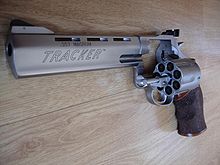
A swing-out cylinder revolver.
The most modernistic method of loading and unloading a revolver is by means of the swing-out cylinder.[42] The showtime swing-out cylinder revolver was patented in France and Britain at the end of December in 1858 by Devisme.[39] The cylinder is mounted on a pin that is parallel to the chambers, and the cylinder swings out and down (to the left in well-nigh cases). An extractor is fitted, operated by a rod projecting from the front of the cylinder assembly. When pressed, it will push all fired rounds free simultaneously (equally in elevation-suspension models, the travel is designed to not completely extract longer, unfired rounds). The cylinder may then exist loaded, individually or once again with the use of a speedloader, closed, and latched in place.[21]
The pivoting part that supports the cylinder is called the crane; it is the weak bespeak of swing-out cylinder designs. Using the method oftentimes portrayed in movies and boob tube of flipping the cylinder open and closed with a moving picture of the wrist tin can in fact cause the crane to bend over time, throwing the cylinder out of alignment with the barrel. Lack of alignment between chamber and barrel is a unsafe condition, as it can impede the bullet's transition from chamber to butt. This gives rise to higher pressures in the chamber, bullet damage, and the potential for an explosion if the bullet becomes stuck.[43]
The shock of firing can exert a dandy bargain of stress on the crane, as in well-nigh designs the cylinder is only held airtight at 1 bespeak, the rear of the cylinder. Stronger designs, such as the Ruger Super Redhawk, use a lock in the crane besides as the lock at the rear of the cylinder. This latch provides a more secure bail between cylinder and frame, and allows the use of larger, more powerful cartridges. Swing-out cylinders are rather strong, but non every bit strong as fixed cylinders, and great care must be taken with the cylinder when loading, so as not to damage the crane.[43]
Other designs [edit]
One unique blueprint was designed past Merwin Hulbert in which the barrel and cylinder assembly were rotated ninety° and pulled frontward to squirt shells from the cylinder.
Activeness [edit]
Single-activity [edit]
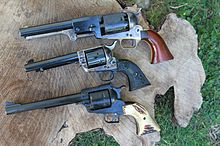
From Superlative: Replica of 1849 vintage. .44 Colt Revolving Holster Pistol (Dragoon); Colt Single Activeness Army Model 1873; Ruger (New Model) Super Blackhawk- Mid and late 20th Century.
In a single-action revolver, the hammer is manually cocked, usually with the pollex of the firing or supporting mitt. This activity advances the cylinder to the adjacent circular and locks the cylinder in place with the bedroom aligned with the barrel. The trigger, when pulled, releases the hammer, which fires the round in the sleeping room. To burn once again, the hammer must exist manually cocked over again. This is chosen "single-action" considering the trigger only performs a single action, of releasing the hammer. Because only a single activity is performed and trigger pull is lightened, firing a revolver in this way allows most shooters to achieve greater accuracy. Additionally, the need to cock the hammer manually acts as a safety. Unfortunately with some revolvers, since the hammer rests on the primer or nipple, accidental discharge from affect is more likely if all 6 chambers are loaded. The Colt Paterson Revolver, the Walker Filly, the Colt's Dragoon and the Colt Single Activeness Army pistol of the American Frontier era are all good examples of this system.[21]
Double-activeness [edit]
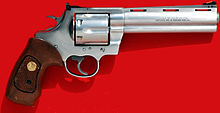
In double-action (DA), the stroke of the trigger pull generates 2 actions:
- The hammer is pulled back to the cocked position which likewise indexes the cylinder to the next round.
- The hammer is released to strike the firing pivot.
Thus, DA means that a cocking action carve up from the trigger pull is unnecessary; every trigger pull volition consequence in a complete cycle. This allows uncocked carry, while also allowing depict-and-burn down using only the trigger. A longer and harder trigger stroke is the trade-off. Nonetheless, this drawback can also be viewed as a safety feature, as the gun is safer confronting accidental discharges from beingness dropped.[21]
Nigh double-activeness revolvers may exist fired in 2 ways.[21]
- The first fashion is single-activeness; that is, exactly the aforementioned as a single-action revolver; the hammer is cocked with the thumb, which indexes the cylinder, and when the trigger is pulled, the hammer is tripped.
- The 2nd mode is double-action, or from a hammer-downwards position. In this case, the trigger first cocks the hammer and revolves the cylinder, then trips the hammer at the rear of the trigger stroke, firing the round in the sleeping accommodation.
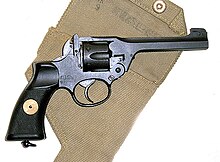
Enfield No. 2 Mk I* double-activity-only revolver. Notation the spurless hammer.
Certain revolvers, called double-activeness-only (DAO) or, more correctly simply less unremarkably, cocky-cocking, lack the latch that enables the hammer to be locked to the rear, and thus can only exist fired in the double-activity mode. With no way to lock the hammer back, DAO designs tend to have bobbed or spurless hammers, and may even have the hammer completely covered by the revolver's frame (i.e., shrouded or hooded). These are generally intended for concealed conveying, where a hammer spur could snag when the revolver is drawn. The potential reduction in accuracy in aimed burn is offset by the increased capability for concealment.[44]
DA and DAO revolvers were the standard-consequence sidearm of endless police departments for many decades. But in the 1980s and 1990s did the semiautomatic pistol begin to make serious inroads later on the advent of rubber actions. The reasons for these choices are the modes of carry and use. Double activity is skilful for high-stress situations because it allows a mode of carry in which "draw and pull the trigger" is the only requirement—no rubber catch release nor divide cocking stroke is required.[44]
Other [edit]
In the cap-and-ball days of the mid 19th century, two revolver models, the English Tranter and the American Brutal "Figure Viii", used a method whereby the hammer was artsy by the shooter's middle finger pulling on a second trigger beneath the main trigger.
Iver Johnson fabricated an unusual model from 1940 to 1947 called the Trigger Cocking Double Action. If the hammer was downwardly, pulling the trigger would cock the hammer. If the trigger was pulled with the hammer cocked, it would and then fire. This meant that to burn the revolver from a hammer downwards land, the trigger must be pulled twice.[45]
3D printed revolver [edit]
The Zig zag revolver is a 3D printed .38 Revolver made public in May 2014.[46] [47] It was created by a $500 3D-printer using plastic filament, only the name of the printer was non revealed by the creator.[47] It was created by a Japanese citizen from Kawasaki named Yoshitomo Imura.[47] He was arrested in May 2014 later he had posted a video online of himself firing a 3D printed Zig Zag revolver.[46] Information technology is the first 3D printed Japanese gun in the world which tin belch alive cartridges.[47]
Use with suppressors [edit]
As a full general rule, revolvers cannot be effective with a sound suppressor ("silencer"), every bit at that place is ordinarily a small gap between the revolving cylinder and the butt which a bullet must traverse or leap when fired. From this opening, a rather loud report is produced. A suppressor can only suppress racket coming from the cage.[48]
A suppressible revolver design does be in the Nagant M1895, a Belgian designed revolver used past Majestic Russia and afterwards the Soviet Union from 1895 through Globe War Ii. This revolver uses a unique cartridge whose case extends beyond the tip of the bullet, and a cylinder that moves forward to place the end of the cartridge inside the barrel when fix to burn. This bridges the gap between the cylinder and the barrel, and expands to seal the gap when fired. While the tiny gap between cylinder and barrel on most revolvers is insignificant to the internal ballistics, the seal is particularly constructive when used with a suppressor, and a number of suppressed Nagant revolvers have been used since its invention.[49]
There is a modernistic revolver of Russian design, the OTs-38,[50] which uses armament that incorporates the silencing mechanism into the cartridge case, making the gap between cylinder and barrel irrelevant as far as the suppression outcome is concerned. The OTs-38 does need an unusually close and precise fit betwixt the cylinder and barrel due to the shape of bullet in the special ammunition (Soviet SP-4), which was originally designed for use in a semi-automatic.
Additionally, the US Military experimented with designing a special version of the Smith & Wesson Model 29 for Tunnel Rats, called the Placidity Special Purpose Revolver or QSPR. Using special .forty caliber ammunition, it never entered official service.[51]
Automatic revolvers [edit]
The term "automated revolver" has ii different meanings, the first existence used in the late nineteenth and early twentieth centuries when "automatic" referred not to the operational mechanism of firing, just of extraction and ejection of spent casings. An "automatic revolver" in this context is 1 which extracts empty fired cases "automatically", i.eastward., upon breaking open the activity, rather than requiring transmission extraction of each example individually with a sliding rod or pin (as in the Filly Single Action Army design). This term was widely used in the advert of the catamenia as a manner to distinguish such revolvers from the far more common rod-extraction types.[52]
In the second sense, "automated revolver" refers to the mechanism of firing rather than extraction. Double-action revolvers utilise a long trigger pull to cock the hammer, thus negating the need to manually cock the hammer between shots. The disadvantage of this is that the long, heavy pull cocking the hammer makes the double-action revolver much harder to shoot accurately than a single-action revolver (although cocking the hammer of a double-action reduces the length and weight of the trigger pull). A rare course of revolvers, called automatic for its firing design, attempts to overcome this restriction, giving the high speed of a double-action with the trigger attempt of a single-action. The Webley-Fosbery Automatic Revolver is the most famous commercial case. It was recoil-operated, and the cylinder and barrel recoiled backwards to cock the hammer and revolve the cylinder. Cam grooves were milled on the outside of the cylinder to provide a means of advancing to the next bedchamber—half a turn as the cylinder moved back, and one-half a turn as it moved forward. .38 caliber versions held 8 shots, .455 caliber versions six. At the time, the few bachelor automated pistols were larger, less reliable, and more than expensive. The automatic revolver was popular when it outset came out, but was quickly superseded past the creation of reliable, cheap semi-automatic pistols.[53]
In 1997, the Mateba company developed a type of recoil-operated automated revolver, commercially named the Mateba Autorevolver, which uses the recoil energy to machine-rotate a normal revolver cylinder holding six or seven cartridges, depending on the model. The company has fabricated several versions of its Autorevolver, including longer-barrelled and carbine variations, chambered in .357 Magnum, .44 Magnum and .454 Casull.[54]
The Pancor Jackhammer is a combat shotgun based on a similar mechanism to an automatic revolver. It uses a accident-forward action to motion the barrel forward (which unlocks it from the cylinder) and so rotate the cylinder and cock the hammer.[55]
Revolving long guns [edit]

Revolvers were not express to handguns and as a longer barrelled arm is more useful in armed forces applications than a sidearm, the idea was applied to both rifles and shotguns throughout the history of the revolver mechanism with mixed degrees of success.[56]
Rifles [edit]
Revolving rifles were an attempt to increase the rate of fire of rifles by combining them with the revolving firing mechanism that had been developed earlier for revolving pistols. Filly began experimenting with revolving rifles in the early 19th century, making them in a variety of calibers and barrel lengths. Colt revolving rifles were the first repeating rifles adopted by the U.S. Government, but they had their problems. They were officially given to soldiers considering of their charge per unit of burn down. But subsequently firing six shots, the shooter had to have an excessive amount of time to reload. Also, on occasion Colt rifles discharged all their rounds at once, endangering the shooter. Even so, an early model was used in the Seminole Wars in 1838.[57] [58] During the Ceremonious War a LeMat Carbine was made based on the LeMat revolver.[59]
Shotguns [edit]
Filly briefly manufactured several revolving shotguns that were met with mixed success. The Filly Model 1839 Shotgun was manufactured between 1839 and 1841. Later, the Colt Model 1855 Shotgun, based on the Model 1855 revolving rifle, was manufactured between 1860 and 1863. Considering of their low production numbers and age they are amongst the rarest of all Colt firearms.[sixty]
The Armsel Striker was a modern accept on the revolving shotgun that held x rounds of 12 Estimate ammunition in its cylinder. It was copied by Cobray every bit the Streetsweeper.[16] [61]
Taurus manufactures a carbine variant of the Taurus Approximate revolver along with its Australian partner company, Rossi known as the Taurus/Rossi Excursion Estimate. It comes in the original combination chambering of .410 bore and .45 Long Colt, too as the .44 Magnum chambering. The rifle has small blast shields attached to the cylinder to protect the shooter from hot gases escaping between the cylinder and barrel.[62]
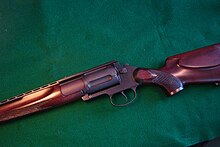
The MTs255 (Russian: МЦ255) is a shotgun fed by a v-round internal revolving cylinder. It is produced past the TsKIB SOO, Central Pattern, and Inquiry Bureau of Sporting and Hunting Arms. They are bachelor in 12, 20, 28, and 32 gauges, and .410 bore.
Other weapons [edit]
The Militarist MM-1, Milkor MGL, RG-6, and RGP-twoscore are grenade launchers that use a revolver action. Because the cylinders are much more massive, they use a bound-wound mechanism to alphabetize the cylinder.
Revolver cannons use a motor-driven revolver-similar mechanism to fire medium caliber armament.
Vi gun [edit]
A six gun is a revolver that holds 6 cartridges. The cylinder in a vi gun is often called a "cycle", and the six gun is itself frequently called a "cycle gun".[63] [64] Although a "six gun" can refer to whatever six-chambered revolver, it is typically a reference to the Colt Unmarried Action Army, or its modern expect-alikes such every bit the Ruger Vaquero and Beretta Stampede.
Until the 1970s, when older-design revolvers such as the Colt Unmarried Action Army and Ruger Blackhawk were re-engineered with drop safeties (such as firing pin blocks, hammer blocks, or transfer bars) that prevent the firing pin from contacting the cartridge's primer unless the trigger is pulled, safety comport required the hammer being positioned over an empty bedchamber, reducing the available cartridges from vi to five, or, on some models, in between chambers on either a pivot or in a groove for that purpose, thus keeping the full six rounds available. This kept the uncocked hammer from resting directly on the primer of a cartridge. If not used in this mode, the hammer rests directly on a primer and unintentional firing may occur if the gun is dropped or the hammer is struck. Some holster makers provided a thick leather thong to place underneath the hammer that both immune the carry of a gun fully loaded with all six rounds and secured the gun in the holster to help prevent its adventitious loss.
Six guns are used commonly by unmarried-activity shooting enthusiasts in shooting competitions, designed to mimic the gunfights of the Sometime West, and for general target shooting, hunting and personal defense force.[65]
Notable brands and manufacturers [edit]
- Robert Adams
- Armscor
- Astra
- Charter Arms
- Chiappa Firearms
- Cimarron Firearms
- Filly's Manufacturing Company
- Fabrique Nationale de Herstal
- Freedom Arms
- Griswold and Gunnison
- Harrington & Richardson
- Iver Johnson
- Janz (revolvers)
- Kimber Manufacturing
- Korth
- Magnum Research
- Manurhin
- Mateba Arms
- Meriden Firearms Co.
- Merwin Hulbert
- Nagant
- North American Arms
- Remington Artillery
- Rossi
- Royal Small Arms Manufactory
- Sturm, Ruger & Co.
- Smith & Wesson
- Taurus Firearms
- United States Fire-Arms Manufacturing Company
- A. Uberti, Srl.
- William Tranter
- Webley & Scott
- Dan Wesson Firearms
Gallery [edit]
-
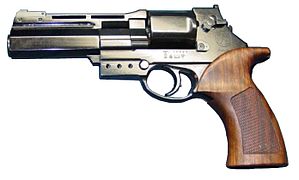
-
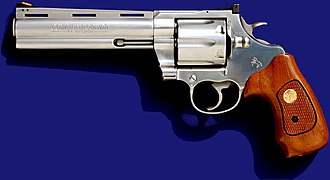
-

-
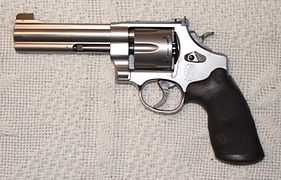
-

-
-
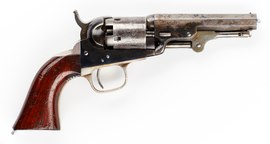
Colt 1849 Pocket Model, made 1850–1873.
-
-

-

North American Arms (NAA) mini revolver in .22 LR. It can fold into its own grip for condom belt prune comport.
Come across also [edit]
- Gunspinning
- List of revolvers
- Mini-revolvers
- Russian roulette
- Turret gun
References [edit]
- ^ Richard A. Haynes (1 January 1999). THE SWAT CYCLOPEDIA: A Handy Desk-bound Reference of Terms, Techniques, and Strategies Associated with the Law Special Weapons and Tactics Function. Charles C Thomas. p. 137. ISBN9780398083434.
Bike Gun The slang term for a revolve handgun that references the rotation of the weapon's cylinder in its firing action, just every bit a wheel turns.
- ^ Tara Dixon Engel (10 September 2015). The Handgun Guide for Women: Shoot Directly, Shoot Safe, and Deport with Conviction. Zenith Press. p. 58. ISBN9781627888103.
Let's start with a revolver, sometimes called a wheel gun.
- ^ Morgan, Michael (2014). Handbook of Mod Percussion Revolvers. Iola, Wisconsin: Krause Publications. p. 75. ISBN978-1-4402-3898-7.
- ^ Howard L. Blackmore (1965). Guns and Rifles of the World. Chancellor Press. p. 80.
- ^ Merrill Lindsay. "Half-dozen SHOOTERS SINCE SIXTEEN HUNDRED" (PDF). Americansocietyofarmscollectors.org . Retrieved 2022-03-02 .
- ^ Kinard, Jeff (2004), Pistols: An Illustrated History of Their Impact, ABC-CLIO, pp. 61–62, ISBN978-1-85109-470-7
- ^ U.South. Patent X9430I1
- ^ Tucker, Spencer C.; White, William Eastward. (2011). The Civil War Naval Encyclopedia. ABC-CLIO. pp. 122–123. ISBN978-1-59884-338-5.
- ^ a b Fadala, Sam (1 Dec 2003). The Gun Digest Blackpowder Loading Manual. Iola, Wisconsin: Krause Publications Craft. p. 28. ISBN0-87349-574-8.
- ^ Houze, Herbert 1000.; Cooper, Carolyn C.; Kornhauser, Elizabeth Mankin (2006). Samuel Colt: Artillery, Fine art, and Invention. Yale Academy Press. p. 118. ISBN0-300-11133-9.
- ^ U.S. Patent 12,648
- ^ a b Flayderman, Norm (2001). Flayderman's Guide to Antiquarian American Firearms ... and their values. Iola, WI: Krause Publications. p. 213. ISBN0-87349-313-3.
- ^ Jinks, Roy Thou.; Sandra C. Krein (2006). Smith & Wesson Images of America. Arcadia Publishing. p. eight. ISBN978-0-7385-4510-3.
- ^ Sapp, Rick (2007). Standard Catalog of Colt Firearms. Iola, WI: Gun Digest Books. p. 79. ISBN978-0896895348.
- ^ a b Kinard, Jeff (2004). Pistols: An Illustrated History of Their Impact . ABC-CLIO. p. 163. ISBN978-1-85109-470-7.
- ^ a b Cutshaw, Charles Q. (2011). Tactical Small Arms of the 21st Century: A Complete Guide to Small Artillery From Effectually the World. Iola, Wisconsin: Gun Digest Books. p. 50. ISBN978-1-4402-2709-vii.
- ^ Pauly, Roger A.; Pauly, Roger (2004). Firearms: The Life Story of a Technology. Greenwood Publishing Group. p. 87. ISBN978-0-313-32796-4.
- ^ Grouping, Diagram (2007). The New Weapons of the World Encyclopedia: An International Encyclopedia from 5000 B.C. to the 21st Century. New York: St. Martin's Press. p. 128. ISBN978-0-312-36832-6.
- ^ Gibby, Darin (2011). Why America Has Stopped Inventing. New York: Morgan James Publishing. p. 84. ISBN978-1-61448-048-8.
- ^ Cumpston, Mike (2005). Percussion Pistols and Revolvers: History, Functioning and Practical Use. iUniverse. pp. 57–58. ISBN978-0-595-35796-3.
- ^ a b c d e f 1000 h i j Tilstone, William J.; Savage, Kathleen A.; Clark, Leigh A. (1 January 2006). Forensic Science: An Encyclopedia of History, Methods, and Techniques. ABC-CLIO. pp. 158–159. ISBN978-i-57607-194-6.
- ^ Eckstine, Roger (2013). Shooter's Bible Guide to Home Defense: A Comprehensive Handbook on How to Protect Your Property from Intrusion and Invasion. Skyhorse Publishing Company, Incorporated. p. 253. ISBN978-1-62873-539-0.
- ^ Supica, Jim; Nahas, Richard (2007). Standard Catalog of Smith & Wesson. Iola, Wisconsin: F+W Media, Inc. p. 301. ISBN978-0-89689-293-four.
- ^ a b Shideler, Dan (2010). Guns Illustrated 2011: The Latest Guns, Specs & Prices. Iola, Wisconsin: F+W Media, Inc. p. 53. ISBN978-1-4402-1624-4.
- ^ Ayoob, Massad (2007). The Gun Digest Book of Combat Handgunnery (Iola, Wisconsin ed.). Gun Digest Books. p. 233. ISBN978-one-4402-1825-5.
- ^ a b c d e f g h i j g l Campbell, Robert K. (2009). The Gun Digest Book of Personal Protection & Domicile Defence. Iola, Wisconsin: Krause Publications. p. 20. ISBN978-1-4402-2443-0.
- ^ Shideler, Dan (7 August 2011). Gun Digest 2012. Iola: Gun Digest Books. p. 430. ISBN978-1-4402-1447-9.
- ^ Keith, Elmer (1955). Sixguns. Salmon, Idaho: Wolfe Publishing Visitor. p. 125. ISBN978-1-879356-09-ii.
- ^ Shideler, Dan (2011). Gun Digest Book of Guns & Prices 2011. Iola, Wisconsin: Gun Assimilate Books. p. 583. ISBN978-1-4402-1896-5.
- ^ Shideler, Dan (26 June 2009). The Gun Digest Book of Modern Gun Values: The Shooter's Guide to Guns 1900-Present. Iola: Gun Digest Books. p. 188. ISBN978-0-89689-824-0.
- ^ Dockery, Kevin (2007). Time to come Weapons. Penguin Group (Usa) Incorporated. p. 289. ISBN978-0-425-21750-four.
- ^ Taylor, Chuck (2009-08-29). "Why The Revolver Won't Go Abroad". Tactical-Life.com. Retrieved 2009-09-16 .
- ^ a b Ahern, Jerry (2010). Gun Digest Buyer'southward Guide to Concealed-Carry Handguns. Iola, Wisconsin: Gun Digest Books. pp. 199–201. ISBN978-i-4402-1743-two.
- ^ Chicoine, David (2005). Guns of the New West: A Shut Upward Look at Modern Replica Firearms. Iola, Wisconsin: Krause Publications. p. 236. ISBN0-87349-768-6.
- ^ Chun, Clayton (2013). U.s.a. Ground forces in the Plains Indian Wars 1865-1891. Osprey Publishing. p. 70. ISBN978-1-4728-0036-seven.
- ^ Ramage, Ken; Sigler, Derrek (2008). Guns Illustrated 2009. Iola, Wisconsin: F+W Media, Inc. p. 133. ISBN978-0-89689-673-4.
- ^ R.K. Campbell. "Tips For Lefties Shooting In a Right Handed World". GunWeek.com. Archived from the original on 2007-09-16. Retrieved 2007-11-13 .
- ^ Radielovic, Marko; Prasac, Max (2012). Big-Bore Revolvers. Iola, Wisconsin: Gun Digest Books. p. 17. ISBN978-1-4402-2856-8.
- ^ a b "English Patents of Inventions, Specifications: 1858, 2958 - 3007". 1859.
- ^ Taffin, John (2005). Kevin Michalowski (ed.). The Gun Digest Book of Cowboy Action Shooting: Guns Gear Tactics. Gun Digest Books. pp. 173–175. ISBN0-89689-140-2.
- ^ Ian V. Hogg (1978). The consummate illustrated encyclopedia of the world'southward firearms . A & Due west Publishers. p. 287. ISBN978-0-89479-031-7.
- ^ Rick, Sindeband (2014-11-30). "Revolver Loading and Unloading".
- ^ a b Sweeney, Patrick (2009). Gunsmithing - Pistols and Revolvers. Iola, Wisconsin: Gun Digest Books. pp. 49–fifty. ISBN978-i-4402-0389-3.
- ^ a b Sweeney, Patrick (2004). The Gun Digest Volume of Smith & Wesson. Iola, Wisconsin: Gun Assimilate Books. p. 284. ISBN0-87349-792-nine.
- ^ S. P. Fjestad (1992). Blueish Book of Gun Values, 13th Ed. Bluish Book Publications, Inc. ISBN0-9625943-4-2.
- ^ a b v Different 3D Printed Gun Models Take Been Fired Since May, 2013 – Here They Are, 3D Print, September 10, 2014. (annal)
- ^ a b c d Japanese Man Arrested For Printing His Own Revolvers, Tech Crunch, May eight, 2014. (archive)
- ^ Thou.D., Vincent J.G. DiMaio (1998). Gunshot Wounds: Applied Aspects of Firearms, Ballistics, and Forensic Techniques, SECOND EDITION. CRC Printing. p. 78. ISBN978-1-4200-4837-7.
- ^ "Silenced 7.62 mm Nagant Revolver". Guns.connect.fi. 2000-09-18. Retrieved 2009-09-16 .
- ^ "OTs-38 silent revolver". Modernistic Firearms. Archived from the original on 2009-08-26. Retrieved 2009-09-sixteen .
- ^ Popenker, Max R. "Smith & Wesson/ AAI Tranquility Special Purpose Revolver/ QSPR/ Tunnel Revolver Archived 2010-04-eighteen at the Wayback Car", globe.guns.ru, Retrieved 2010-04-05
- ^ Boorman, Dean K. (1 December 2002). The History of Smith & Wesson Firearms. Globe Pequot Printing. p. 44. ISBN978-1-58574-721-4.
- ^ Kinard, Jeff (2004). Pistols: An Illustrated History of Their Impact. ABC-CLIO. p. 144. ISBN978-ane-85109-470-7.
- ^ Shideler, Dan (2011). Gun Digest 2012. Iola, Wisconsin: Gun Assimilate Books. p. 416. ISBN978-1-4402-2891-9.
- ^ Bishop, Chris (2006). The Encyclopedia of Weapons: From World State of war Ii to the Present Mean solar day. San Diego, California: Thunder Bay Press. p. 355.
- ^ Troiani, Don; Kochan, James L.; Coates, Earl J.; James Kochan (1998). Don Troiani'southward Soldiers in America, 1754-1865 . Stackpole Books. p. 214. ISBN978-0-8117-0519-six.
- ^ Coggins, Jack (2012). Arms and Equipment of the Civil State of war. Courier Dover Publications. pp. 36–37. ISBN978-0-486-13127-6.
- ^ Dizard, Jan E.; Muth, Robert M.; Andrews, Stephen P. (1999). Guns in America: A Reader. New York: NYU Press. p. 62. ISBN978-0-8147-1879-7.
- ^ Shideler, Dan (x May 2011). The Gun Digest Book of Guns & Prices 2011. Iola, Wisconsin: Gun Assimilate Books. pp. 555–556. ISBN978-1-4402-1890-3.
- ^ Sapp, Rick (2007). Standard Itemize of Filly Firearms. Iola, Wisconsin: Gun Assimilate Books. pp. 198, 209. ISBN978-i-4402-2697-7.
- ^ Jones, Richard D.; White, Andrew (27 May 2008). Jane's Guns Recognition Guide 5e. HarperCollins. p. 355. ISBN978-0-06-137408-1.
- ^ Muramatsu, Kevin (2013). The Gun Digest Volume of Centerfire Rifles Associates/Disassembly. Iola, Wisconsin: Krause Publications. p. 310. ISBN978-1-4402-3544-iii.
- ^ Smith, Clint (September 2004). "Wheel guns are real guns". Findarticles.com. Guns Mag. Archived from the original on 2012-07-09. Retrieved 17 September 2010.
- ^ Gromer, Cliff (August 2002). "New Guns of the Former West". Popular Mechanics: 86–89.
- ^ Handloader Ammunition Reloading Journal, August 2009 edition in the "From the Hip" article by Brian Pearce. Page 32.
External links [edit]
| | Wikimedia Commons has media related to Revolvers. |
- U.S. Patent RE124—Revolving gun
- U.S. Patent 1,304—Improvement in firearms
- U.S. Patent 7,613—Revolver
- U.S. Patent 7,629—Revolver
- U.S. Patent 12,648—Repeating firearm
- U.S. Patent 12,649—Revolver
davenportwainewhim.blogspot.com
Source: https://en.wikipedia.org/wiki/Revolver

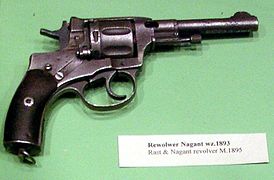
0 Response to "When Will Rossi Guns Hit the Market Again?"
Enviar um comentário